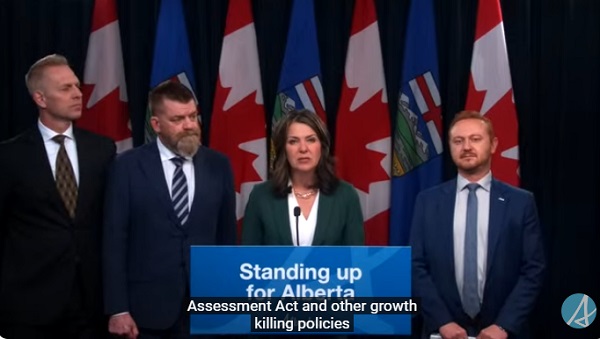Alberta
Alberta taking Trudeau government to court to fight unconstitutional Impact Assessment Act

Alberta’s government is again taking the federal government to court over its unconstitutional Impact Assessment Act after they failed to meet the province’s four-week deadline.
Impact Assessment Act lands Ottawa in court again |
In October 2023, the Supreme Court of Canada concluded that the Impact Assessment Act was largely unconstitutional. On June 20, 2024, the federal government amended the Impact Assessment Act as part of a large omnibus budget bill. The amendments fail to correct the constitutional deficiencies the Supreme Court of Canada identified with the original legislation and will continue killing jobs and hurting the economy.
Alberta’s government gave the federal government a four-week deadline to remedy the unconstitutional provisions in the amended Impact Assessment Act or face another legal challenge. The federal government has failed to address Alberta’s concerns, showing a continued disregard and refusal to engage with Alberta on the legislation and its flawed amendments. In response, Alberta has referred the constitutionality of the amended Impact Assessment Act to the Court of Appeal of Alberta.
“We have tried working with Ottawa to change their deeply flawed and unconstitutional Impact Assessment Act but we’ve been met with resistance every step of the way. They have chosen to disregard our input, disregard a Supreme Court of Canada decision, and disregard our deadline, so we’ll see them in court. Again. We will not stand down on this issue.”
The federal government’s Impact Assessment Act enables Ottawa to derail, delay and interfere in projects that have little or nothing to do with matters falling within federal jurisdiction. Alberta’s government has been consistent in its response and continues to wait for the federal government to engage meaningfully and make meaningful amendments to the legislation.
Alberta’s government asked the federal government to:
- Eliminate federal encroachment into provincial jurisdiction.
- Recognize equivalency and the ability to fully substitute our provincial environmental assessment for a federal impact assessment.
- Create certainty for industry and increase investor confidence by imposing concrete timelines and curbing ministerial discretion.
- Emphasize that significant adverse effects within federal jurisdiction is the minimum threshold for federal involvement.
- Streamline the process by scoping projects appropriately and placing some parameters on public involvement.
- Focus the public interest decision-making process on significant adverse effects within federal jurisdiction and countervailing positive effects.
“The federal government needs to respect the decisions of the Supreme Court and stop making meaningless attempts to bypass the rulings of Canada’s highest court. The courts agreed with Alberta in the first legal challenge, and we are prepared to fight as many times as is necessary to defend the rights of Albertans against this blatant overreach.”
Alberta
They never wanted a pipeline! – Deputy Conservative Leader Melissa Lantsman

From Melissa Lantsman
Turns out the anti-development wing of the Liberal Party never stopped running the show.
Today, we’ll see if the Liberals vote for the pipeline they just finished bragging about.
Spoiler: they won’t. Because with the Liberals, the announcements are real, but the results never are.
Alberta
Premier Smith: Canadians support agreement between Alberta and Ottawa and the major economic opportunities it could unlock for the benefit of all

From Energy Now
By Premier Danielle Smith
Get the Latest Canadian Focused Energy News Delivered to You! It’s FREE: Quick Sign-Up Here
If Canada wants to lead global energy security efforts, build out sovereign AI infrastructure, increase funding to social programs and national defence and expand trade to new markets, we must unleash the full potential of our vast natural resources and embrace our role as a global energy superpower.
The Alberta-Ottawa Energy agreement is the first step in accomplishing all of these critical objectives.
Recent polling shows that a majority of Canadians are supportive of this agreement and the major economic opportunities it could unlock for the benefit of all Canadians.
As a nation we must embrace two important realities: First, global demand for oil is increasing and second, Canada needs to generate more revenue to address its fiscal challenges.
Nations around the world — including Korea, Japan, India, Taiwan and China in Asia as well as various European nations — continue to ask for Canadian energy. We are perfectly positioned to meet those needs and lead global energy security efforts.
Our heavy oil is not only abundant, it’s responsibly developed, geopolitically stable and backed by decades of proven supply.
If we want to pay down our debt, increase funding to social programs and meet our NATO defence spending commitments, then we need to generate more revenue. And the best way to do so is to leverage our vast natural resources.
At today’s prices, Alberta’s proven oil and gas reserves represent trillions in value.
It’s not just a number; it’s a generational opportunity for Alberta and Canada to secure prosperity and invest in the future of our communities. But to unlock the full potential of this resource, we need the infrastructure to match our ambition.
There is one nation-building project that stands above all others in its ability to deliver economic benefits to Canada — a new bitumen pipeline to Asian markets.
The energy agreement signed on Nov. 27 includes a clear path to the construction of a one-million-plus barrel-per-day bitumen pipeline, with Indigenous co-ownership, that can ensure our province and country are no longer dependent on just one customer to buy our most valuable resource.
Indigenous co-ownership also provide millions in revenue to communities along the route of the project to the northwest coast, contributing toward long-lasting prosperity for their people.
The agreement also recognizes that we can increase oil and gas production while reducing our emissions.
The removal of the oil and gas emissions cap will allow our energy producers to grow and thrive again and the suspension of the federal net-zero power regulations in Alberta will open to doors to major AI data-centre investment.
It also means that Alberta will be a world leader in the development and implementation of emissions-reduction infrastructure — particularly in carbon capture utilization and storage.
The agreement will see Alberta work together with our federal partners and the Pathways companies to commence and complete the world’s largest carbon capture, utilization and storage infrastructure project.
This would make Alberta heavy oil the lowest intensity barrel on the market and displace millions of barrels of heavier-emitting fuels around the globe.
We’re sending a clear message to investors across the world: Alberta and Canada are leaders, not just in oil and gas, but in the innovation and technologies that are cutting per barrel emissions even as we ramp up production.
Where we are going — and where we intend to go with more frequency — is east, west, north and south, across oceans and around the globe. We have the energy other countries need, and will continue to need, for decades to come.
However, this agreement is just the first step in this journey. There is much hard work ahead of us. Trust must be built and earned in this partnership as we move through the next steps of this process.
But it’s very encouraging that Prime Minister Mark Carney has made it clear he is willing to work with Alberta’s government to accomplish our shared goal of making Canada an energy superpower.
That is something we have not seen from a Canadian prime minister in more than a decade.
Together, in good faith, Alberta and Ottawa have taken the first step towards making Canada a global energy superpower for benefit of all Canadians.
Danielle Smith is the Premier of Alberta
-

 COVID-192 days ago
COVID-192 days agoUniversity of Colorado will pay $10 million to staff, students for trying to force them to take COVID shots
-

 Bruce Dowbiggin2 days ago
Bruce Dowbiggin2 days agoIntegration Or Indignation: Whose Strategy Worked Best Against Trump?
-

 Focal Points2 days ago
Focal Points2 days agoCommon Vaccines Linked to 38-50% Increased Risk of Dementia and Alzheimer’s
-

 espionage2 days ago
espionage2 days agoWestern Campuses Help Build China’s Digital Dragnet With U.S. Tax Funds, Study Warns
-

 Opinion2 days ago
Opinion2 days agoThe day the ‘King of rock ‘n’ roll saved the Arizona memorial
-

 Bruce Dowbiggin1 day ago
Bruce Dowbiggin1 day agoWayne Gretzky’s Terrible, Awful Week.. And Soccer/ Football.
-

 Agriculture1 day ago
Agriculture1 day agoCanada’s air quality among the best in the world
-

 Health1 day ago
Health1 day agoCDC Vaccine Panel Votes to End Universal Hep B Vaccine for Newborns






